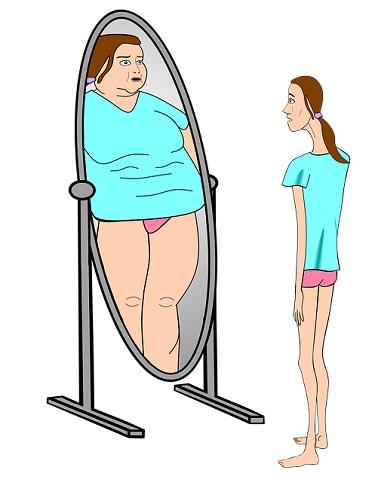
Modernity in the Western world has certainly provided humanity with new valuable means and improvements in almost all spheres of life: medicine, nutrition, fashion, technology, finance, etc. However, besides its beneficial progress, modernity has also brought along with it its own unique maladies. One of these contemporary afflictions is self-obsessive worries and anxieties with body image, which in many unfortunate cases are reflected in eating disorders, whilst the vast majority of the afflicted are female.
In 1993, the feminist researcher Susan Bordo published an essay called “Anorexia Nervosa: Psychopathy as the Crystallization of Culture” as part of her essay collection in Unbearable Weight: Feminism, Western Culture, and the Body, which studies the phenomenon of anorexia. Interestingly, the main principles of this essay also echo almost precisely a lot of elements in Sylvia Plath’s poetry, even if anorexia is not explicitly mentioned in the poems. This essay will discuss and exhibit how Bordo’s ideas are materialized in several poems by the modern American poet Sylvia Plath.
In her essay, Bordo divides the “streams or currents” (page 142) that can prompt anorexia into three: “the dualist axis,” “the control axis,” and “the gender/power axis”; each one holds its own set of attributes and characteristics. For the purpose of this paper, each of these sources will be measured and compared separately with one of Sylvia Plath’s poems, which evince the same or very similar features: the dualist axis with “In Plaster,” the control axis with “Face Lift” and the gender/power axis with “The Applicant.”
At the beginning of her elucidation of the dualist axis, Bordo explains that four central features of the ancient familiar dualism – “the bodily or the material” and “the mental or the spiritual” – concoct the core components of the anorectic’s “basic body imagery” (page 144). Equivalently, in Plath’s “In Plaster,” this dualism manifests itself right in the first line as the speaker professes, “There are two of me now.” As the poem’s title suggests, it seems that the speaker underwent some medical procedure, and now she is in plastic or a cast. Thus, the bodily is the “absolutely white person,” the new body that is in a cast; and the mental is the “old yellow one,” the remaining mind and thoughts that actually speak in the poem.
The first central feature of Bordo’s dualist axis is to experience the body “as alien, as the not-self, the not-me” (page 144). In Plath’s poem, the speaker clearly alienates herself from the “white person” by the pronouns “I,” “me” and “my” versus “she” and “her.”
The second central feature is to experience the body “as confinement and limitation … from which the soul, will, or mind struggles to escape” (page 144). The speaker in “In Plastic” makes numerous proclamations that parallel this description of entrapment: she asserts that she “shall never get out of this,” that her other self “could cover [her] mouth and eyes,” that she “wasn’t in any position to get rid of her” and that “[l]iving with [her other self] was like living with [her] own coffin.” These statements surely align with Bordo’s confining definition.
The third central feature is that “the body is the enemy” (page 145). This feature reverberates strongly in Plath’s “In Plaster,” in which there is an increasingly growing hostility between the speaker and her other-self. At first, the speaker states that her other self “is certainly the superior one,” that she “hated her” and that she even “hit her” then, for a short while, the speaker claims that they got along as their “relationship grew more intense”; but ultimately, the speaker believes that her other-self “began to hope [she’d] die,” and the animosity culminates when the speaker “see[s] it must be one or the other of [them].”
The fourth and final central feature is that the body is perceived as “the locus of all that threatens our attempts at control” (page 145). It is clear that in Plath’s poem, there is an undergoing battle of control between the two selves, as previously noted; and this clash reaches its climax in the last stanza, where the speaker proclaims that currently, she is “collecting [her] strength” and thereafter that “one day [she] shall manage without her.” As illustrated, it is therefore evident that Plath’s poem demonstrates all four central features of Bordo’s dualist axis.
In her segment about the control axis, Bordo determines that “contemporary culture appears more obsessed than previous eras with the control of the unruly body” (page 149); this statement already corresponds with Plath’s poem “Face Lift” just with the poem’s mere title. The procedure of a face lift (medically named “rhytidectomy”) is a distinct attempt to control and alter the human body, and indeed, it only became contemporarily possible in the 20th century – the first time surgery of this sort was performed and recorded was in 1901 in Germany (Panfilov: 2005).
Bordo implicates the parents as well, at least partially, in their child’s dire anorectic state: the “parents expect a great deal of her in the way of individual achievement (as well as physical appearance)”; but not only that, the child initially gets absorbed by the twisted sensation of bodily control “often at the suggestion of a parent” (page 149). These unnerving contentions speak in volumes, even if just briefly, in Plath’s “Face Lift”: while the speaker narrates herself as a nine-year-old child at the hospital, apparently undergoing a sort of cosmetic surgery, her “mother swam up, holding a tin basin” – a conspicuous indication of the mother’s troubling association. Bordo explains that physical pains “do not trouble the anorectic” and furthermore, “her ability to ignore them is further proof to her of her mastery of her body” (page 149).
Comparably, in “Face Lift” the speaker casually depicts a painful image in which her “[s]kin doesn’t have roots, it peels away easy as paper”; in accordance with Bordo, she disturbingly relates to the physical pain in an apathetic manner and thereafter she even describes herself grinning while “the stitches tauten.” Bordo later specifies two sources from which the anorectic derives the feeling of “total master of the body” (page 152): the self-assured capability to “overcome all physical obstacles” and the excitement of “being in total charge” of the body’s shape. These two sources are discernible all throughout “Face Lift,” and mostly in the final stanza in which the speaker complacently and joyfully rejoices that the “dewlapped lady” – her old face – is “done for” and can “die there”; her sensation of total control is expressed beautifully and all the same appallingly in her declaration that she is now “Mother” to herself. Thus, the aspects of Bordo’s control axis are vocalized distressfully in Plath’s poem “Face Lift.”
The third and last stream that Bordo describes is the gender/power axis, in which she elaborates how anorexia is essentially the aftermath of oppressive power relations between the predominant men and women within the patriarchal Western society. In her poem “The Applicant,” Plath personifies society as a voice of an alleged corporate job interviewer, who is the sole speaker in the poem; this personified speaker enunciates most of the same chief cultural woes that Bordo raises in her essay.
Bordo claims that while unphysical merits such as intelligence, experience or effectiveness “still go a long way for men,” women can only achieve the same “status of romantic or sexual ideal” with the “appropriate body” (page 154). Similarly, whereas the speaker in “The Applicant” is presumably gender-neutral, he still reduces the female status below that of the male. The most conspicuous reductive statement of the woman by the poem’s speaker to the applicant, which is actually objectification, is the ironic reiteration of “Will you marry it?” [emphasis added]; the woman is not considered a human being in the eyes of society but rather a mindless object.
Bordo connects anorexia with feminism and associates it with the possibility of “unconscious feminist protest” and a “fierce rebellion against … the same direction as their mothers’ lives” (page 156); later on, she supplements this rebellious notion by adding that anorexia is “the dimension of protest against the limitations of the ideal of female domesticity” (page 159). Plath exhibits this feminist rebelliousness against female domesticity through a few sardonic utterances of the speaker in “The Applicant”: the speaker offers to fill the applicant’s empty hand with another hand – a synecdoche for the wife and an image of marriage – to “bring teacups and roll away headaches,” and thereafter, he asserts that the symbolic hand will “do whatever you tell it.”
Bordo adds that the anorectic also feels “terrified and repelled … by the traditional female domestic role” and additionally by the “archetypal image of the female” (page 160). These feelings of fear and repulsion with the gender-based power relations are palpable in “The Applicant” through the strong irony in the speaker’s voice, which in addition to all aforementioned remarks, refers to the woman as a “living doll” that “can sew” and “cook” – verbs that are traditionally associated with the female domestic space. It is, therefore, thus how Plath’s poem epitomizes Bordo’s gender/power axis.
As equated and compared, this essay connects the fundamental foundations of Susan Bordo’s essay about anorexia with the poetry of Sylvia Plath, although anorexia itself is not named expressly in the poems. This shows that modern Western culture does struggle with ailments from which anorexia is derived and is evidenced in other “symptoms” as well, such as Plath’s poetry. As a final note, it is fascinating to observe how two different women from two different fields relate to the same cultural illness from different directions and ultimately carry the same ideas and message about the yet unfulfilled and so desired goal of gender equality.
Works Cited:
Bordo, Susan. 1993. “Anorexia Nervosa: Psychopathy as the Crystallization of Culture.” Unbearable Weight: Feminism, Western Culture, and the Body. Berkeley: University of California Press.
Panfilov, Dimitrije E. 2005. Cosmetic Surgery Today. Translated by Grahame Larkin. New York: Thieme Medical Publishers.



